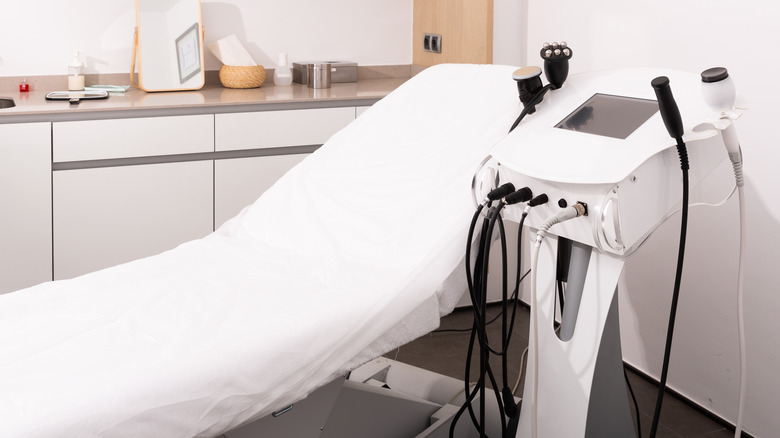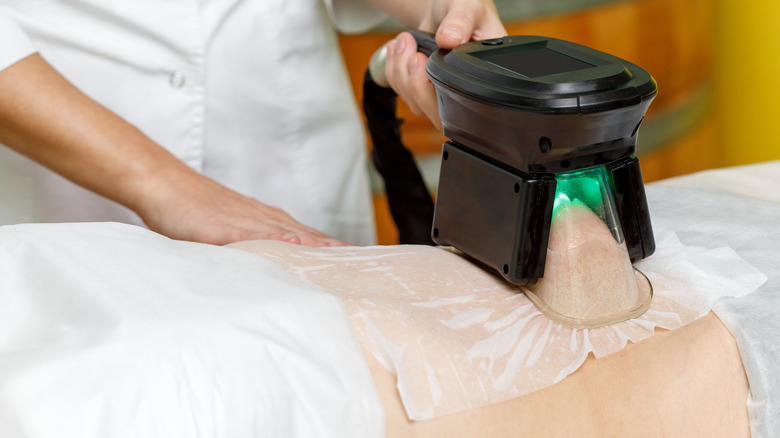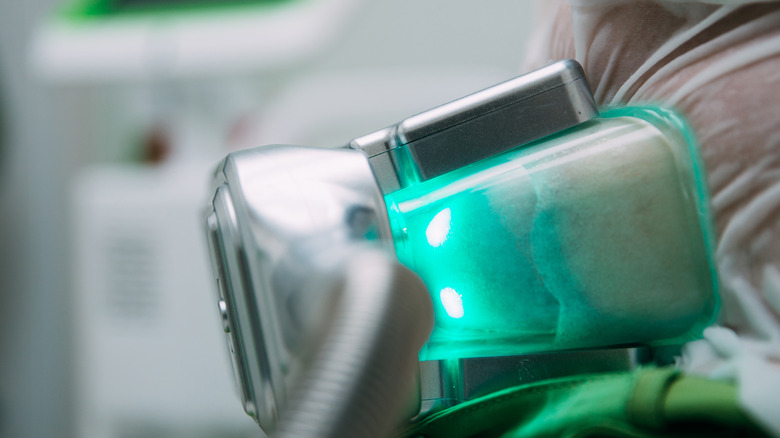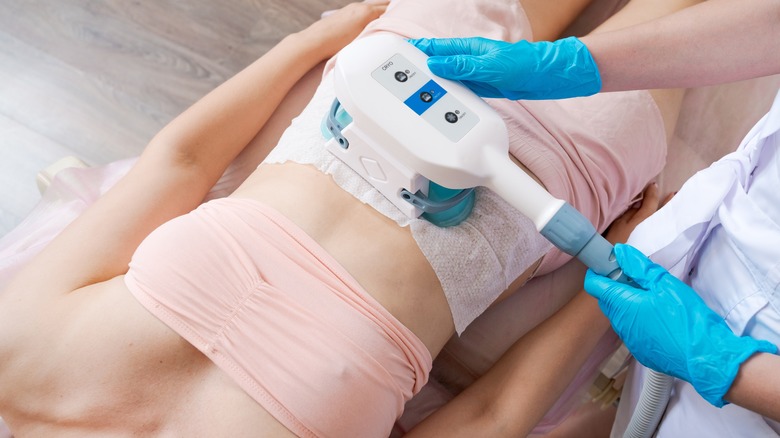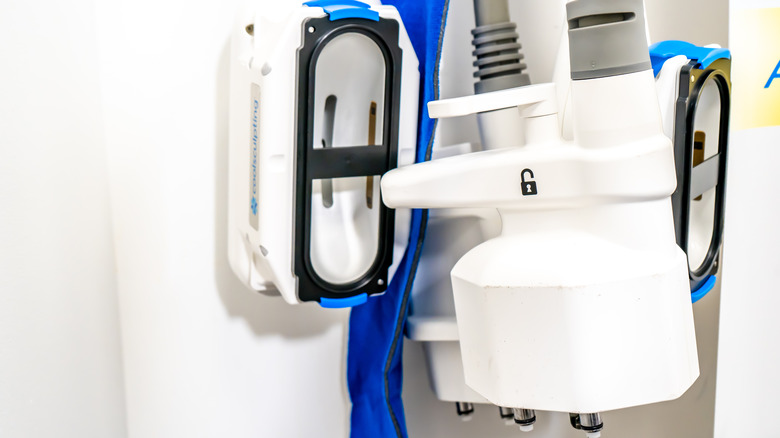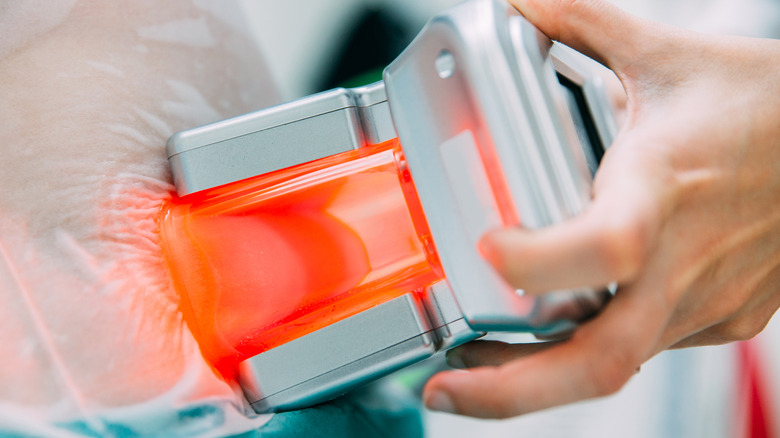What You Need To Know About The Risks Of CoolSculpting
If you've ever searched for weight loss treatments, there's no doubt you have stumbled across a procedure called CoolSculpting. CoolSculpting is a newer treatment meant to help weight loss through a noninvasive freezing treatment on body fat cells. Thought of as a safe alternative to liposuction, this procedure has become increasingly popular in the last couple of years. Most of its popularity stems from the permanent results it promises along with a simple procedure.
According to Insider, the manufacturers behind CoolSculpting have treated around eight million people through this procedure as of 2019. Although fairly new for a procedure, CoolSculpting was approved by the FDA in 2010. The entire process is done inside a doctor's office and takes less time than getting surgery.
With such an easy process and rising popularity, CoolSculpting sounds like a no-brainer. However, while the results sound promising, there are important risks and side effects you should consider before deciding on CoolSculpting.
What is the CoolSculpting process?
Part of the allure of the CoolSculpting process is its simplicity. According to InStyle, a doctor uses a two-paddle device to freeze fat cells in the target area. Freezing the fat cells kills unwanted tissue and leaves fewer cells in the area. Over time, the body flushes out the dead fat cells, reducing the area by 20% to 25%. The whole process happens over a series of around two to four CoolSculpting procedures, depending on the person and the target area. Depending on the target area, the procedure may cost an average of $2,000 to $4,000 in total and takes around two hours per session.
Since the process is non-invasive and doesn't involve surgery, there is no recovery time needed. CoolSculpting targets a specific layer underneath the skin that's found under the arms, waist, and legs. This layer is called subcutaneous fat and is the fat that can become resistant to exercise and diet (via Healthline).
Who can get CoolSculpting?
While the results may be promising, not everyone is a match for this procedure. According to Vogue, the best match for CoolSculpting is someone who is not expecting a major result. Because of the risks and side effects, potential patients would be those who only need minor improvements in their weight loss journey. Furthermore, doctors take into consideration whether the target tissue is thick or thin as this can affect the end result.
Dr. Joshua Zeichner, M.D. also warns that CoolSculpting is not an ultimate weight loss procedure and should be treated as a cosmetic surgery instead. Zeichner reiterates that the purpose of CoolSculpting is to simply eliminate small areas of stubborn subcutaneous fat (via Everyday Health). Because the layer of fat being frozen is the one closest to the skin, it isn't optimal for those who have visceral fat. Visceral fat refers to the fat that surrounds vital organs. Zeichner states that if it is "pinchable," it is subcutaneous fat. Therefore, CoolSculpting is best for those who want to get rid of subcutaneous fat but would be at risk in surgery.
CoolSculpting timeline and results
While CoolSculpting is noninvasive and nonsurgical, the results will take time to show. After the final CoolSculpting session, patients can expect to wait a few months for the work to show. According to Renew MD, the typical wait time to see results is three to four months. Since the process freezes and removes fat cells, the procedure is considered permanent. Even though dead fat cells cannot grow back, patients could still gain the lost weight back in the target area if they don't maintain a healthy lifestyle.
After this three to four-month period, patients can expect to see an average of 25% thinner appearance in the target area. While waiting, patients can expect to see a slow thinning as the body slowly rids itself of the dead cells (via Laser Aesthetic Center).
It's also important to note that while CoolSculpting reports a zero recovery time, this may not apply to everyone. Potential side effects could cause a period of pain after the procedure that could leave patients out of their routine. In more severe cases, additional surgeries that include additional recovery time may be necessary.
The side effects and risks of CoolSculpting
Like any procedure, CoolSculpting has its side effects and risks that potential patients should be aware of. According to Cosmetic Dermatology Center, mild side effects include pain, bruising, tenderness, and numbing in the target area. However, in most cases, these side effects would go away on their own after a few days and shouldn't affect a patient going about their day.
In certain cases, CoolSculpting could cause a longer period of pain and numbing that could last longer than just a few days. However, this mainly occurs when the treating doctor is inexperienced with the device. One of the few rare side effects is the risk of slight nerve pain (via WebMD).
Another rare risk of CoolSculpting is a condition called paradoxical adipose hyperplasia. Although rare, this side effect has become the main concern since actress Linda Evangelista shared her diagnosis of paradoxical adipose hyperplasia with People.
What is paradoxical adipose hyperplasia?
Paradoxical adipose hyperplasia, or PAH, is a severe risk of CoolSculpting that could have unfortunate consequences. Generally, PAH can cause disfigurement of skin and pain in the long run. MedicineNet notes that PAH is considered very rare. While there is no evidence to prove that a specific demographic is at risk of PAH, most cases have been found in men. PAH was also found to be found when targeting the midsection area.
PAH happens when the target mass hardens and expands rather than freeze and diminish. This causes the fat to get bigger and sometimes takes the shape of the CoolSculpting machine. In certain cases, PAH can be resolved via surgery. Patients would need to wait a six to nine-month period before the fat could soften up, making it easier for doctors to be able to remove it safely through liposuction. However, there are few cases in which, despite liposuction, PAH could come back permanently (via Anderson Sobel Cosmetic).
